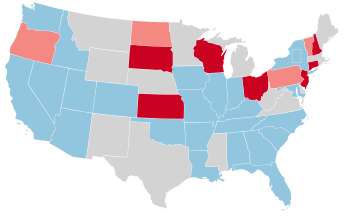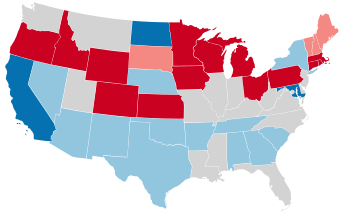The 1938 United States elections were held on November 8, 1938, in the middle of Democratic President Franklin D. Roosevelt's second term. The Democratic Party lost 72 seats, mostly to the Republican Party, in the House of Representatives. The Democrats also lost eight seats to the Republicans in the U.S. Senate.[3] Despite these heavy losses, the Democrats maintained control of Congress.
| ← 1936 1937 1938 1939 1940 → Midterm elections | |
| Election day | November 8 |
|---|---|
| Incumbent president | Franklin D. Roosevelt (Democratic) |
| Next Congress | 76th |
| Senate elections | |
| Overall control | Democratic hold |
| Seats contested | 36 of 96 seats (32 Class 3 seats + 6 special elections)[1] |
| Net seat change | Republican +8[2] |
 | |
| 1938 Senate election results
Democratic gain Democratic hold | |
| House elections | |
| Overall control | Democratic hold |
| Seats contested | All 435 voting seats |
| Popular vote margin | Democratic +1.2% |
| Net seat change | Republican +81 |
 | |
| 1938 House election results
Democratic gain Democratic hold | |
| Gubernatorial elections | |
| Seats contested | 33 |
| Net seat change | Republican +12 |
 | |
| 1938 gubernatorial election results
Democratic gain Democratic hold | |
The election was a defeat for Roosevelt, as the conservative coalition (an alliance of Republicans and Southern Democrats) took control of Congress and stymied Roosevelt's domestic agenda. Roosevelt had campaigned openly against members of his own party who had not supported the New Deal, but Roosevelt's preferred candidates met with little success across the country. The election took place in the aftermath of the recession of 1937–38 and the defeat of the Judicial Procedures Reform Bill of 1937 ("the court-packing plan"), and President Roosevelt was at the nadir of his popularity. Republicans picked up congressional seats for the first time since the start of the Great Depression, and few new major domestic programs became law until the advent of the Great Society in the 1960s.[4]
See also
editReferences
edit- ^ Two Class 3 seats held both a regularly-scheduled election and a special election in 1938. These two seats are not double-counted for the total number of seats contested.
- ^ Republicans picked up seven seats in the regularly-scheduled elections and won an additional seat in the special elections.
- ^ "Statistics of the Congressional Election of November 8, 1938" (PDF). U.S. House of Reps, Office of the Clerk. Retrieved 28 December 2011.
- ^ Busch, Andrew (1999). Horses in Midstream. University of Pittsburgh Press. pp. 122–126.
Further reading
edit- Carson, Jamie L. "Electoral and Partisan Forces in the Roosevelt Era: The US Congressional Elections of 1938." Congress & the Presidency 28#2 (2001) 161–183 https://doi.org/10.1080/07343460109507751
- Dunn, Susan (2010). Roosevelt's Purge: How FDR Fought to Change the Democratic Party. ISBN 978-0674057173. (Excerpt and text search)
- Plesur, Milton (1962). "The Republican Congressional Comeback of 1938". Review of Politics. 24 (4): 525–562. doi:10.1017/S0034670500012419. JSTOR 1405361. S2CID 145405461.
- Price, Charles M.; Boskin, Joseph (1966). "The Roosevelt 'Purge': A Reappraisal". Journal of Politics. 28 (3): 660–670. doi:10.2307/2128161. JSTOR 2128161. S2CID 154528656.
- Savage, Sean J. (1991). "Chapter 6". Roosevelt, the Party Leader, 1932-1945. pp. 129–158. ISBN 0813130794. (Excerpt and text search); also in JSTOR